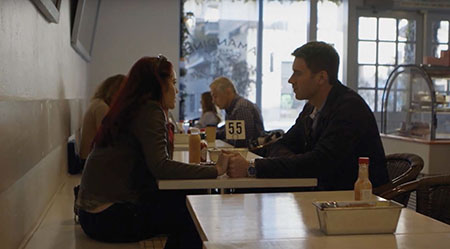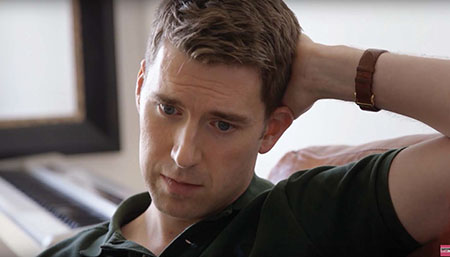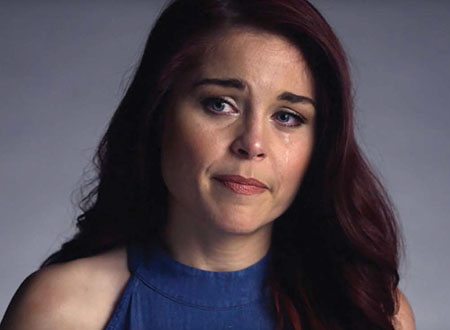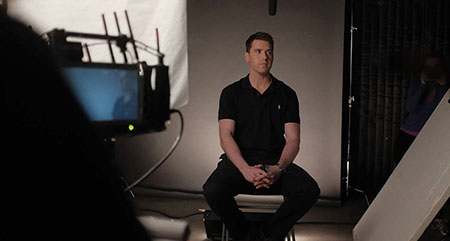Lighting for Freeform Shooting
I stopped doing documentary production when I moved to Los Angeles and had since been doing narrative and commercial, so when I was suddenly presented with a documentary series where I was not allowed to bring many lights, I was very intrigued. The doc series “It Got Real” was supposed to feel and look like real life, and it was, as we followed our subjects around with cameras over a series of days.

Erin and Matt Robinson in “It Got Real.” Lighting from windows was used by pointing the cameras toward them.
Interviews were intercut with real events like doctor’s appointments, drives through Beverly Hills and a surgery. This felt like ENG shooting, which I had also done when I was starting out, capturing real events as they happen without manipulating the look much, if at all.
AVAILABLE LIGHT AND SOURCES
In instances where not many lights could be implemented when following subjects around, I had to think about the available light and sources in the spaces. Where there were windows, I would try to point toward them with the cameras.
Most everything was shot during the day, either exterior or interior, so I had an Aputure LS-1 LED that was daylight temperature handy at all times. This was used to fill any room that needed more ambience despite having a window or more, or for returning the light of a window that we were facing.

Matt Robinson during an interview in his home
We also did many long “on-the-fly” interviews on location, so this acted as a key light I could pop up quickly. For any night interiors inside apartments, I had incandescent bulbs to swap out with any bulbs in the rooms that I might have been seeing. I could ensure not only that all the sources inside a single room matched, but if I had them in my frame, they wouldn’t be so hot that information was lost in the image.
Quite simply, the best approach for freeform documentary-style shooting is to understand the lighting technology you will be faced with in the different locations. If you can scout, scout. I knew I had a lot of daylight to utilize and expose for, but I also had some night scenes without the daylight pouring in.
I had fluorescent fixtures I had to throw some minus-green gel on prior to the subjects entering the space so I could make it all look a little less tinted. I knew what color temperature to balance the camera for before going in on the day. Obviously, having a camera with a higher dynamic range and better color is also a plus and more forgiving when you get into the color suite later.

Erin Robinson in an interview for “It Got Real”
SHOOTING IN THE MOMENT
Ultimately, when shooting something that is happening in the moment that you cannot go back and get again later, you cannot micromanage subjects with marks. As with any narrative or commercial, the more you prepare, the better you will be on the day, even if things change on you last minute.
For the interview portion of the doc series “It Got Real,” we lit with some older tungsten units and a few Kino Flo fluorescents. We threw one Kino on the gray backdrop behind the subject in the A camera to add some shape in the background, and created a book light with a 1K ARRI tungsten fresnel as a key.
Despite the subject matter being quite dramatic and real, we chose not to exclude fill light, so we walked in a 4x4 bounce board to return some of the key light on the other side of the face.
I knew the interviews would be cut frequently with bright scenes with a lot of ambient light, and figured that something with a lot of contrast would not fit as well with the action we captured outside the interview; it would be too dramatic a difference. Instead, we made it soft and controlled the shadows rather than let them fall off completely.

On the interview set from camera A we used a 4x4 bounce board to return some of the key light on the other side of the face.
Going into a shoot without much lighting technology can be an ultimate test of lighting knowledge and can boost creative thinking. Despite the fact that it becomes so minimalistic in terms of sources and tools, you still go into it with the same thinking process—analyze what you have in terms of units, windows, colors and spaces. Then utilize them to the best of your ability. The more you understand, the better your work will be even though you don’t fly in a bunch of supplemental lighting in the first place.
Observing light in life is one of the easiest and most accessible methods of studying for cinematography. It not only helps in your recreation of something such as office lighting with fluorescents or daylight through a window at noon, but it also helps you control these elements and make them work for you when you are without anything else.
Julia Swain is a cinematographer based in California, whose narrative films include “Killing Animals,” “Jilted” and “Cassidy Red.” She continues to shoot on a variety of formats, seeking to create compelling visuals for every story and brand. She can be contacted through TV Technology.
Get the TV Tech Newsletter
The professional video industry's #1 source for news, trends and product and tech information. Sign up below.
